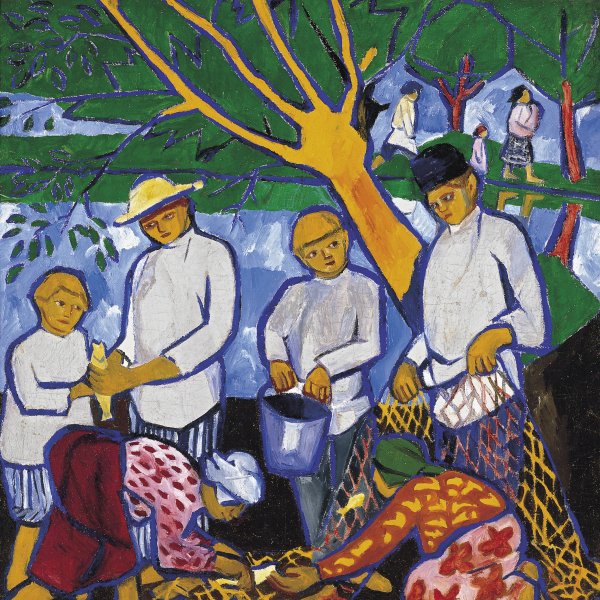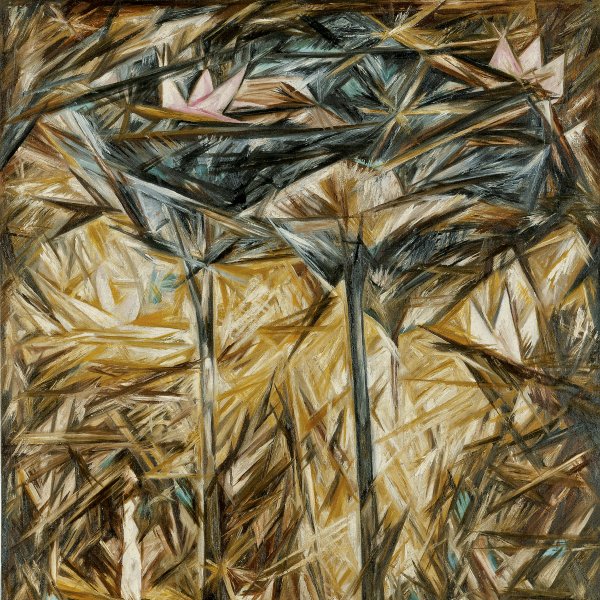Natalia Goncharova
Negaievo, 1881-Paris, 1962
Natalia Goncharova was notable for her leadership of the Russian avant-garde before the Soviet Revolution and for her intense collaboration in the staging of the ballets of her compatriot Serge Diaghilev. Born into a family belonging to the rural gentry and the great-granddaughter of Alexander Pushkin, she was raised on a farm in the province of Tula and enrolled at the Moscow School of Painting, Sculpture and Architecture in 1898. There she met Mikhail Larionov, who would be her companion in both art and life until the end of her days.
Goncharova became acquainted with French Post-Impressionist art through The Golden Fleece exhibition of 1908, which had a decisive influence on some of her works that depicted predominantly Russian rural themes. She was a founding member of the Jack of Diamonds group in 1910. Two years later she and Larionov left the group to start The Donkey’s Tail, and she played the main role in the exhibition by that name. At this point some of her works continued to be connected directly with the world of icons and Russian folk art, whereas others were beginning to clearly display the influence of Cubism and Futurism. She subsequently evolved to Rayonism, a style in which she produced a series of forests in 1913. Her oeuvre was well received by critics and public alike, although her lifestyle — a far cry from social conventionalisms — was always surrounded by a certain amount of controversy.
In 1914 Goncharova was involved in the production of Diaghilev’s Le Coq d’or, the first of a whole series of collaborations that led her to become known in France and the West chiefly as a set designer. She travelled with Diaghilev and Larionov to Switzerland, Italy and Spain, and when they settled in Paris their joint work continued to be highly fruitful. Diaghilev’s death in 1929 marked a certain decline in her creativity.
Goncharova and Larionov married in 1955. A few months before she died in 1962, the London Arts Council organised a retrospective exhibition of the work of both artists, acknowledging their importance on the twentiethcentury Russian and European art scene.
Goncharova became acquainted with French Post-Impressionist art through The Golden Fleece exhibition of 1908, which had a decisive influence on some of her works that depicted predominantly Russian rural themes. She was a founding member of the Jack of Diamonds group in 1910. Two years later she and Larionov left the group to start The Donkey’s Tail, and she played the main role in the exhibition by that name. At this point some of her works continued to be connected directly with the world of icons and Russian folk art, whereas others were beginning to clearly display the influence of Cubism and Futurism. She subsequently evolved to Rayonism, a style in which she produced a series of forests in 1913. Her oeuvre was well received by critics and public alike, although her lifestyle — a far cry from social conventionalisms — was always surrounded by a certain amount of controversy.
In 1914 Goncharova was involved in the production of Diaghilev’s Le Coq d’or, the first of a whole series of collaborations that led her to become known in France and the West chiefly as a set designer. She travelled with Diaghilev and Larionov to Switzerland, Italy and Spain, and when they settled in Paris their joint work continued to be highly fruitful. Diaghilev’s death in 1929 marked a certain decline in her creativity.
Goncharova and Larionov married in 1955. A few months before she died in 1962, the London Arts Council organised a retrospective exhibition of the work of both artists, acknowledging their importance on the twentiethcentury Russian and European art scene.






